Alpha - Dbl: A reasonable high secure double - block - length hash function
Chúng tôi đề xuất một hàm nén độ
dài khối kép mới được gọi là Alpha-DBL. Lược đồ
này sử dụng hai lược đồ độ dài khối đơn an toàn
song song dựa trên mã khối với khóa 𝟐𝒏-bit và
kích thước khối 𝒏-bit để nén chuỗi 𝟑𝒏-bit thành
chuỗi 𝟐𝒏-bit. Chúng tôi đã chứng minh rằng, lược
đồ Alpha-DBL đạt được cận an toàn kháng va
chạm và kháng tiền ảnh gần như tối ưu (tối đa 𝟐𝒏
và 𝟐𝟐𝒏 truy vấn tương ứng để tìm va chạm và tiền
ảnh). Cụ thể với 𝒏 = 𝟏𝟐𝟖, một kẻ tấn công bất kỳ
thực hiện ít hơn 𝟐𝒏−𝟏.𝟐𝟕 = 𝟐𝟏𝟐𝟔.𝟕𝟑 truy vấn chỉ có
thể tìm thấy một va chạm với xác suất nhỏ hơn 1/2.
Theo hiểu biết của chúng tôi, cận an toàn kháng va
chạm này tốt hơn so với các hàm nén khác. Ngoài
ra, chúng tôi đã đưa ra phân tích độ an toàn kháng
tiền ảnh của Alpha-DBL cho thấy cận an toàn là
2𝟐𝟐𝒏−𝟓 = 𝟐𝟐𝟓𝟏 truy vấn cho 𝒏 = 𝟏𝟐𝟖. Sử dụng
lược đồ này trong việc xây dựng hàm băm được
lặp có thể bảo toàn độ an toàn kháng va chạm và
an toàn kháng tiền ảnh
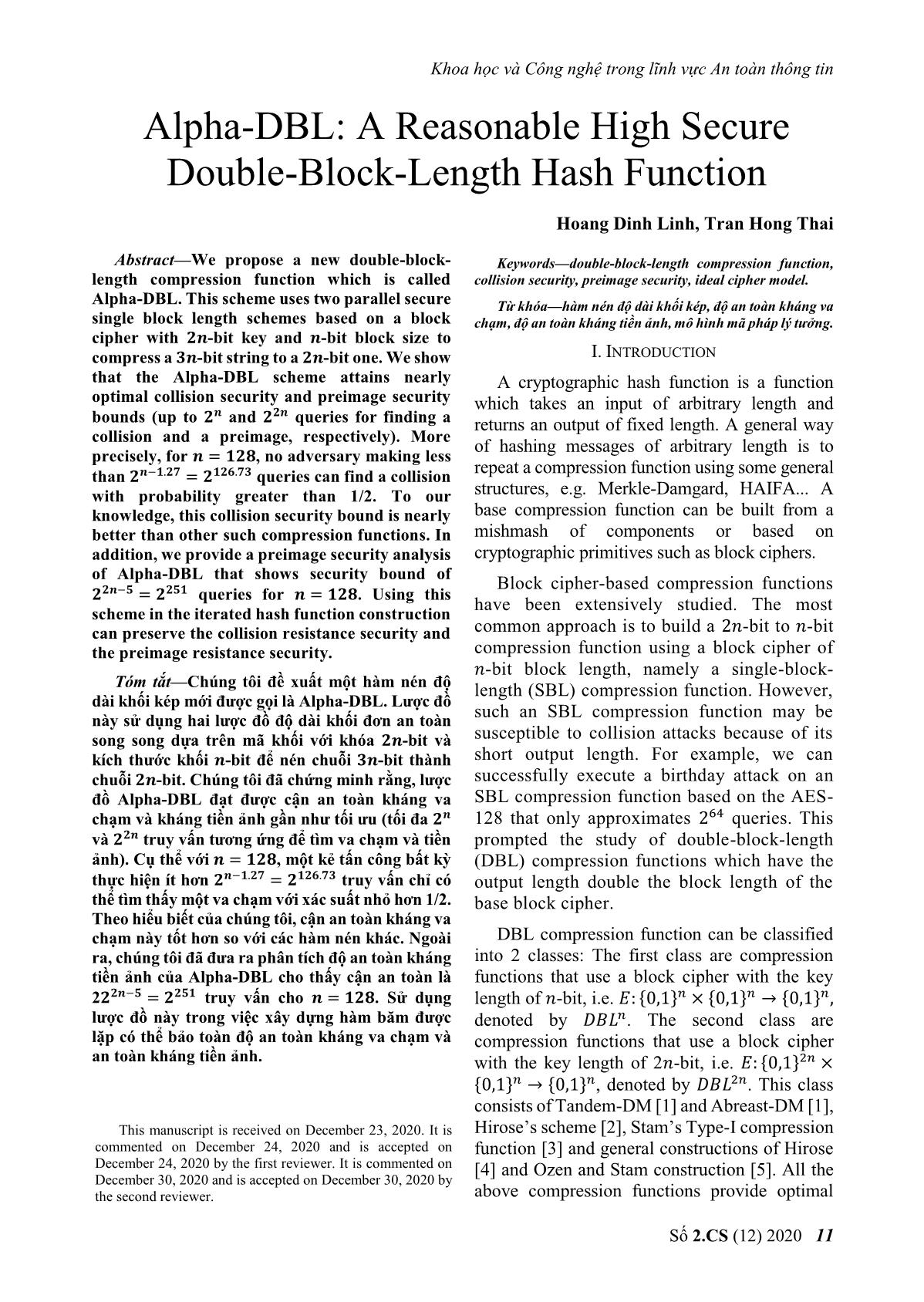
Trang 1
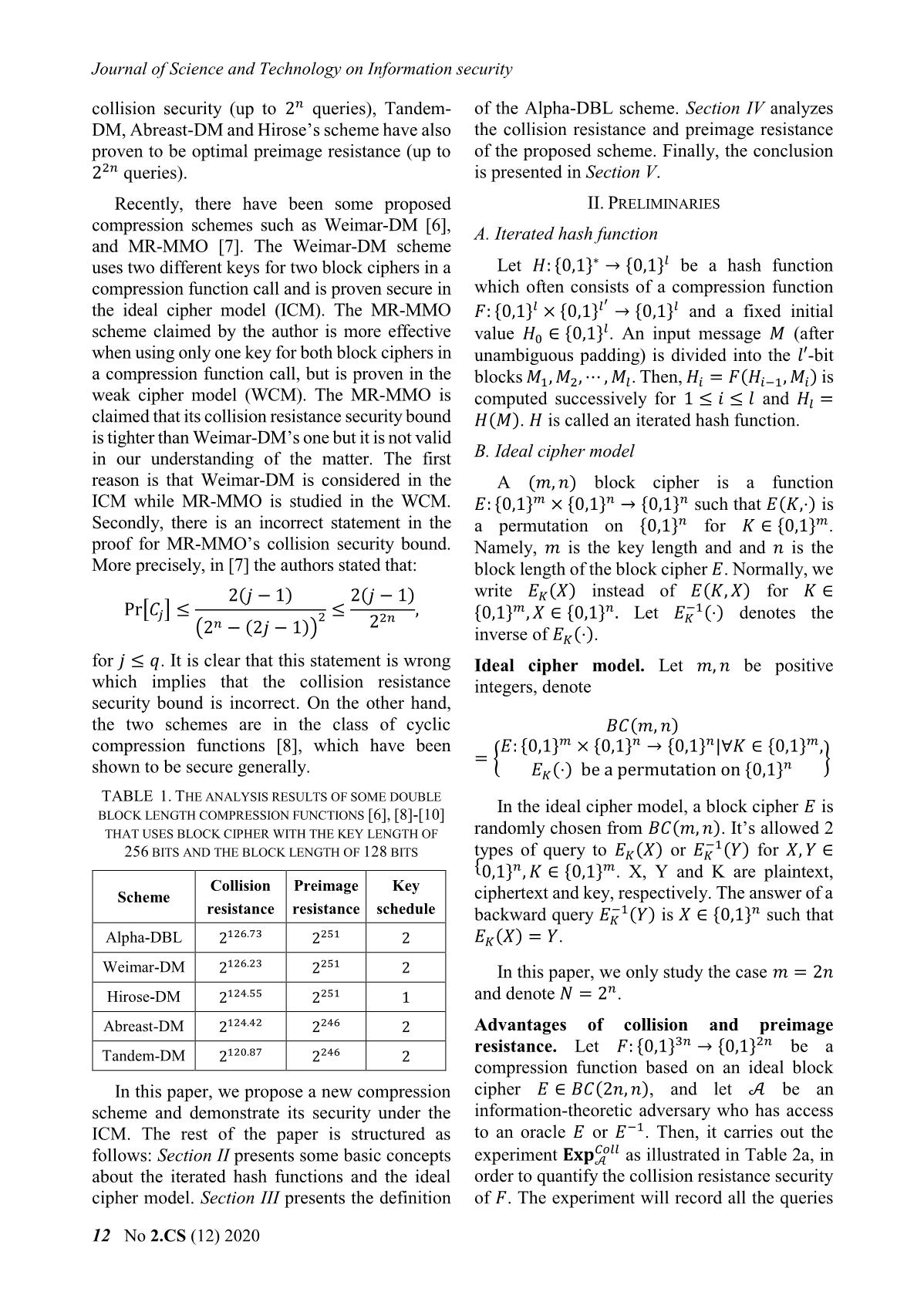
Trang 2
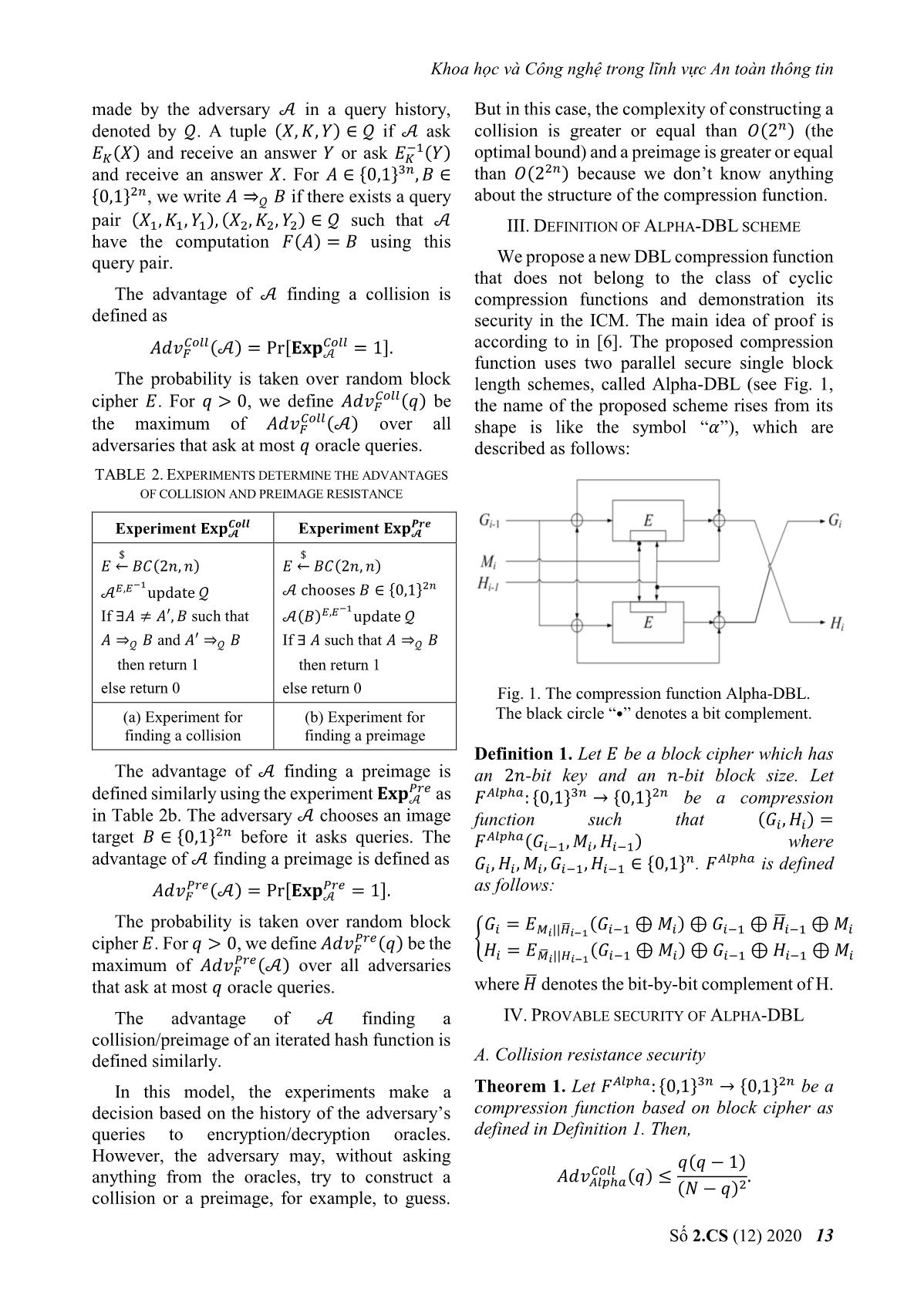
Trang 3
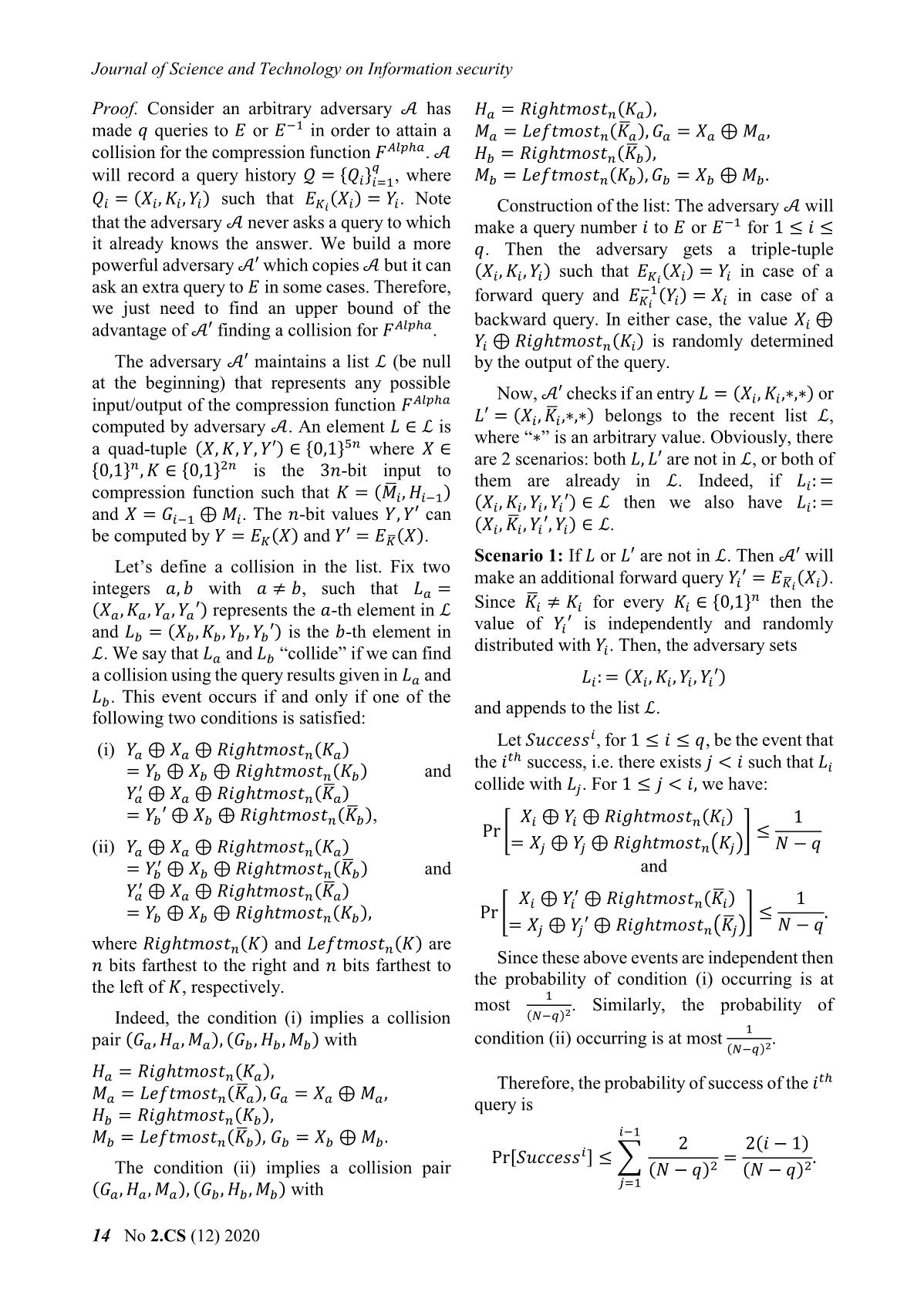
Trang 4
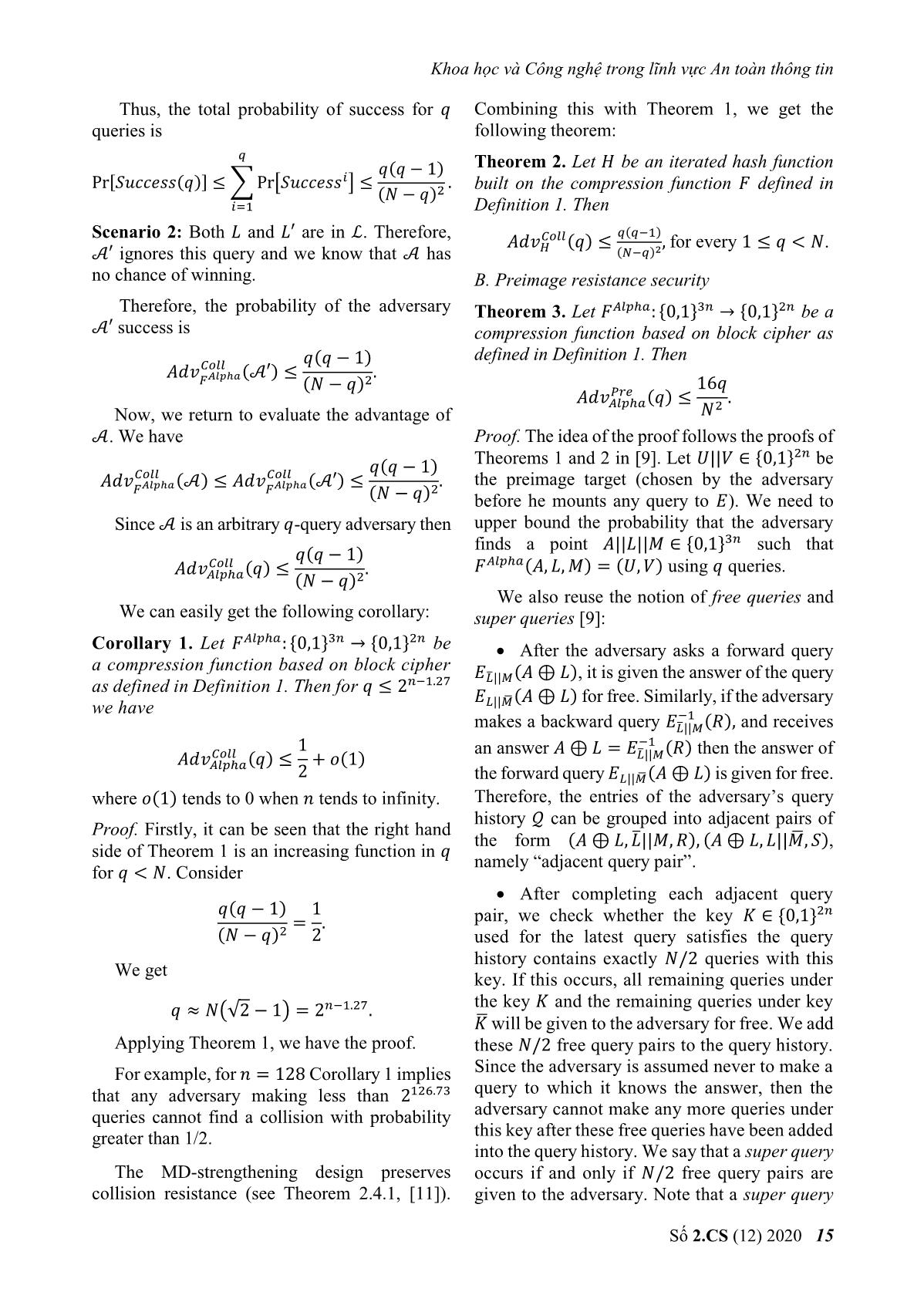
Trang 5
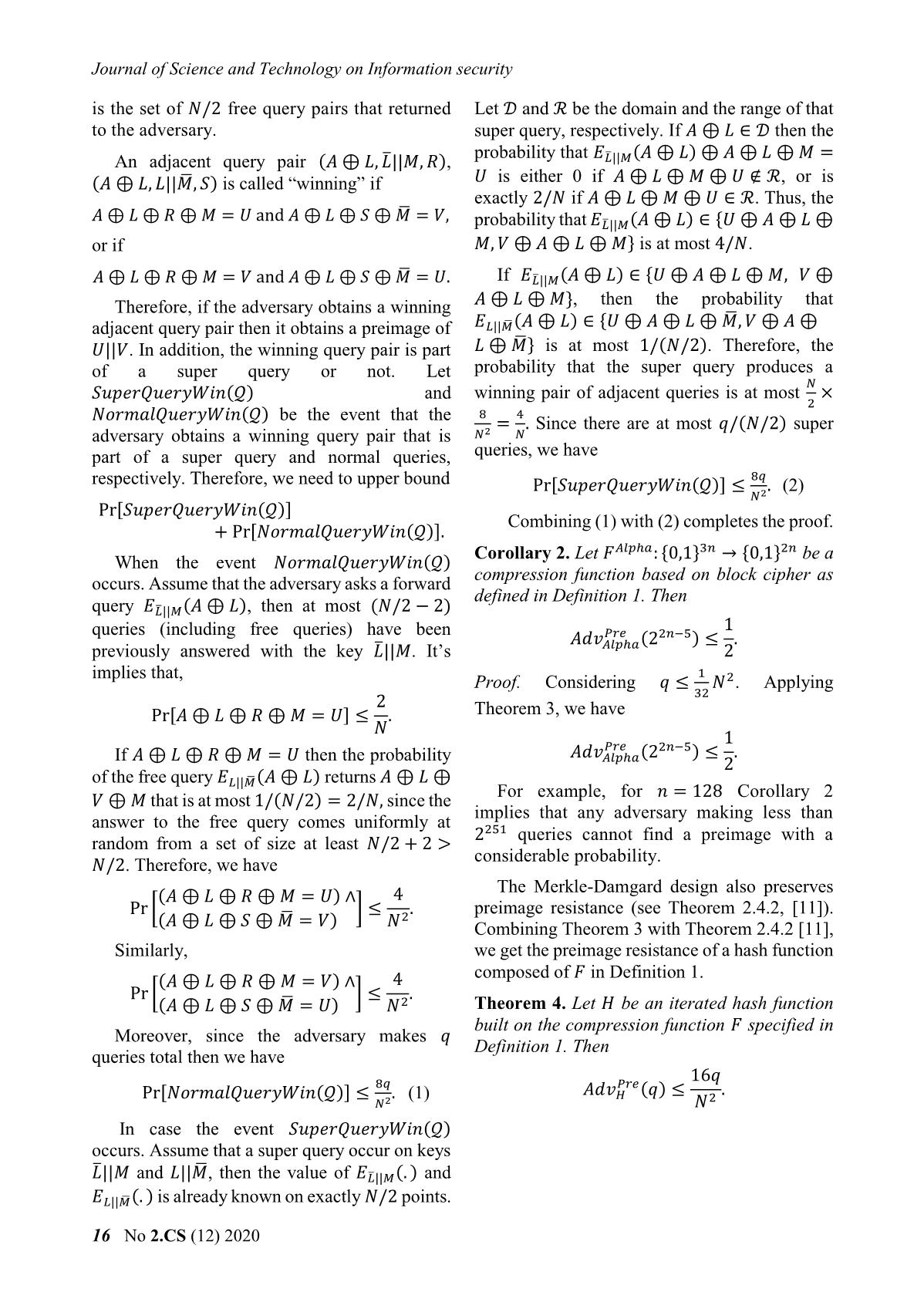
Trang 6
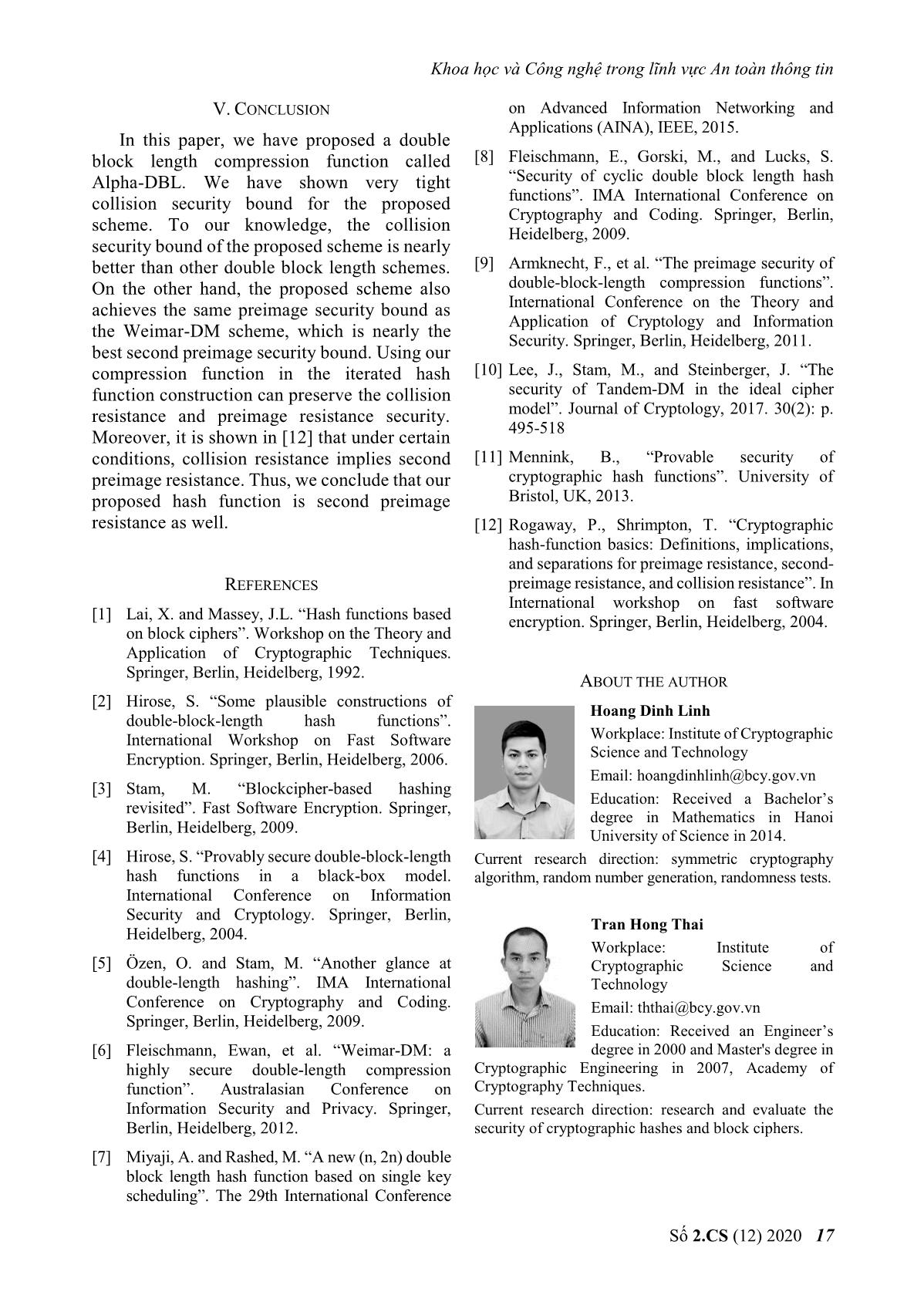
Trang 7
Tóm tắt nội dung tài liệu: Alpha - Dbl: A reasonable high secure double - block - length hash function
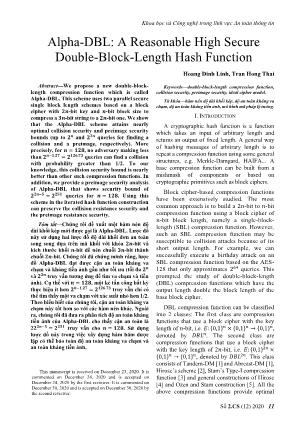
Khoa học và Công nghệ trong lĩnh vực An toàn thông tin
Số 2.CS (12) 2020 11
Hoang Dinh Linh, Tran Hong Thai
Abstract—We propose a new double-block-
length compression function which is called
Alpha-DBL. This scheme uses two parallel secure
single block length schemes based on a block
cipher with 𝟐𝒏-bit key and 𝒏-bit block size to
compress a 𝟑𝒏-bit string to a 𝟐𝒏-bit one. We show
that the Alpha-DBL scheme attains nearly
optimal collision security and preimage security
bounds (up to 𝟐𝒏 and 𝟐𝟐𝒏 queries for finding a
collision and a preimage, respectively). More
precisely, for 𝒏 = 𝟏𝟐𝟖, no adversary making less
than 𝟐𝒏−𝟏.𝟐𝟕 = 𝟐𝟏𝟐𝟔.𝟕𝟑 queries can find a collision
with probability greater than 1/2. To our
knowledge, this collision security bound is nearly
better than other such compression functions. In
addition, we provide a preimage security analysis
of Alpha-DBL that shows security bound of
𝟐𝟐𝒏−𝟓 = 𝟐𝟐𝟓𝟏 queries for 𝒏 = 𝟏𝟐𝟖. Using this
scheme in the iterated hash function construction
can preserve the collision resistance security and
the preimage resistance security.
Tóm tắt—Chúng tôi đề xuất một hàm nén độ
dài khối kép mới được gọi là Alpha-DBL. Lược đồ
này sử dụng hai lược đồ độ dài khối đơn an toàn
song song dựa trên mã khối với khóa 𝟐𝒏-bit và
kích thước khối 𝒏-bit để nén chuỗi 𝟑𝒏-bit thành
chuỗi 𝟐𝒏-bit. Chúng tôi đã chứng minh rằng, lược
đồ Alpha-DBL đạt được cận an toàn kháng va
chạm và kháng tiền ảnh gần như tối ưu (tối đa 𝟐𝒏
và 𝟐𝟐𝒏 truy vấn tương ứng để tìm va chạm và tiền
ảnh). Cụ thể với 𝒏 = 𝟏𝟐𝟖, một kẻ tấn công bất kỳ
thực hiện ít hơn 𝟐𝒏−𝟏.𝟐𝟕 = 𝟐𝟏𝟐𝟔.𝟕𝟑 truy vấn chỉ có
thể tìm thấy một va chạm với xác suất nhỏ hơn 1/2.
Theo hiểu biết của chúng tôi, cận an toàn kháng va
chạm này tốt hơn so với các hàm nén khác. Ngoài
ra, chúng tôi đã đưa ra phân tích độ an toàn kháng
tiền ảnh của Alpha-DBL cho thấy cận an toàn là
2𝟐𝟐𝒏−𝟓 = 𝟐𝟐𝟓𝟏 truy vấn cho 𝒏 = 𝟏𝟐𝟖. Sử dụng
lược đồ này trong việc xây dựng hàm băm được
lặp có thể bảo toàn độ an toàn kháng va chạm và
an toàn kháng tiền ảnh.
This manuscript is received on December 23, 2020. It is
commented on December 24, 2020 and is accepted on
December 24, 2020 by the first reviewer. It is commented on
December 30, 2020 and is accepted on December 30, 2020 by
the second reviewer.
Keywords—double-block-length compression function,
collision security, preimage security, ideal cipher model.
Từ khóa—hàm nén độ dài khối kép, độ an toàn kháng va
chạm, độ an toàn kháng tiền ảnh, mô hình mã pháp lý tưởng.
I. INTRODUCTION
A cryptographic hash function is a function
which takes an input of arbitrary length and
returns an output of fixed length. A general way
of hashing messages of arbitrary length is to
repeat a compression function using some general
structures, e.g. Merkle-Damgard, HAIFA... A
base compression function can be built from a
mishmash of components or based on
cryptographic primitives such as block ciphers.
Block cipher-based compression functions
have been extensively studied. The most
common approach is to build a 2𝑛-bit to 𝑛-bit
compression function using a block cipher of
𝑛-bit block length, namely a single-block-
length (SBL) compression function. However,
such an SBL compression function may be
susceptible to collision attacks because of its
short output length. For example, we can
successfully execute a birthday attack on an
SBL compression function based on the AES-
128 that only approximates 264 queries. This
prompted the study of double-block-length
(DBL) compression functions which have the
output length double the block length of the
base block cipher.
DBL compression function can be classified
into 2 classes: The first class are compression
functions that use a block cipher with the key
length of 𝑛-bit, i.e. 𝐸: {0,1}𝑛 × {0,1}𝑛 → {0,1}𝑛,
denoted by 𝐷𝐵𝐿𝑛. The second class are
compression functions that use a block cipher
with the key length of 2𝑛-bit, i.e. 𝐸: {0,1}2𝑛 ×
{0,1}𝑛 → {0,1}𝑛, denoted by 𝐷𝐵𝐿2𝑛. This class
consists of Tandem-DM [1] and Abreast-DM [1],
Hirose’s scheme [2], Stam’s Type-I compression
function [3] and general constructions of Hirose
[4] and Ozen and Stam construction [5]. All the
above compression functions provide optimal
Alpha-DBL: A Reasonable High Secure
Double-Block-Length Hash Function
Journal of Science and Technology on Information security
12 No 2.CS (12) 2020
collision security (up to 2𝑛 queries), Tandem-
DM, Abreast-DM and Hirose’s scheme have also
proven to be optimal preimage resistance (up to
22𝑛 queries).
Recently, there have been some proposed
compression schemes such as Weimar-DM [6],
and MR-MMO [7]. The Weimar-DM scheme
uses two different keys for two block ciphers in a
compression function call and is proven secure in
the ideal cipher model (ICM). The MR-MMO
scheme claimed by the author is more effective
when using only one key for both block ciphers in
a compression function call, but is proven in the
weak cipher model (WCM). The MR-MMO is
claimed that its collision resistance security bound
is tighter than Weimar-DM’s one but it is not valid
in our understanding of the matter. The first
reason is that Weimar-DM is considered in the
ICM while MR-MMO is studied in the WCM.
Secondly, there is an incorrect statement in the
proof for MR-MMO’s collision security bound.
More precisely, in [7] the authors stated that:
Pr[𝐶𝑗] ≤
2(𝑗 − 1)
(2𝑛 − (2𝑗 − 1))
2 ≤
2(𝑗 − 1)
22𝑛
,
for 𝑗 ≤ 𝑞. It is clear that this statement is wrong
which implies that the collision resistance
security bound is incorrect. On the other hand,
the two schemes are in the class of cyclic
compression functions [8], which have been
shown to be secure generally.
TABLE 1. THE ANALYSIS RE ... �ℎ𝑡𝑚𝑜𝑠𝑡𝑛(�̅�𝑎)
= 𝑌𝑏 ⊕ 𝑋𝑏 ⊕ 𝑅𝑖𝑔ℎ𝑡𝑚𝑜𝑠𝑡𝑛(𝐾𝑏),
where 𝑅𝑖𝑔ℎ𝑡𝑚𝑜𝑠𝑡𝑛(𝐾) and 𝐿𝑒𝑓𝑡𝑚𝑜𝑠𝑡𝑛(𝐾) are
𝑛 bits farthest to the right and 𝑛 bits farthest to
the left of 𝐾, respectively.
Indeed, the condition (i) implies a collision
pair (𝐺𝑎 , 𝐻𝑎 , 𝑀𝑎), (𝐺𝑏, 𝐻𝑏 , 𝑀𝑏) with
𝐻𝑎 = 𝑅𝑖𝑔ℎ𝑡𝑚𝑜𝑠𝑡𝑛(𝐾𝑎),
𝑀𝑎 = 𝐿𝑒𝑓𝑡𝑚𝑜𝑠𝑡𝑛(𝐾𝑎), 𝐺𝑎 = 𝑋𝑎 ⊕ 𝑀𝑎 ,
𝐻𝑏 = 𝑅𝑖𝑔ℎ𝑡𝑚𝑜𝑠𝑡𝑛(𝐾𝑏),
𝑀𝑏 = 𝐿𝑒𝑓𝑡𝑚𝑜𝑠𝑡𝑛(�̅�𝑏), 𝐺𝑏 = 𝑋𝑏 ⊕ 𝑀𝑏.
The condition (ii) implies a collision pair
(𝐺𝑎 , 𝐻𝑎 , 𝑀𝑎), (𝐺𝑏, 𝐻𝑏, 𝑀𝑏) with
𝐻𝑎 = 𝑅𝑖𝑔ℎ𝑡𝑚𝑜𝑠𝑡𝑛(𝐾𝑎),
𝑀𝑎 = 𝐿𝑒𝑓𝑡𝑚𝑜𝑠𝑡𝑛(𝐾𝑎), 𝐺𝑎 = 𝑋𝑎 ⊕ 𝑀𝑎 ,
𝐻𝑏 = 𝑅𝑖𝑔ℎ𝑡𝑚𝑜𝑠𝑡𝑛(�̅�𝑏),
𝑀𝑏 = 𝐿𝑒𝑓𝑡𝑚𝑜𝑠𝑡𝑛(𝐾𝑏), 𝐺𝑏 = 𝑋𝑏 ⊕ 𝑀𝑏.
Construction of the list: The adversary 𝒜 will
make a query number 𝑖 to 𝐸 or 𝐸−1 for 1 ≤ 𝑖 ≤
𝑞. Then the adversary gets a triple-tuple
(𝑋𝑖, 𝐾𝑖 , 𝑌𝑖) such that 𝐸𝐾𝑖(𝑋𝑖) = 𝑌𝑖 in case of a
forward query and 𝐸𝐾𝑖
−1(𝑌𝑖) = 𝑋𝑖 in case of a
backward query. In either case, the value 𝑋𝑖 ⊕
𝑌𝑖 ⊕ 𝑅𝑖𝑔ℎ𝑡𝑚𝑜𝑠𝑡𝑛(𝐾𝑖) is randomly determined
by the output of the query.
Now, 𝒜′ checks if an entry 𝐿 = (𝑋𝑖, 𝐾𝑖 ,∗,∗) or
𝐿′ = (𝑋𝑖, 𝐾𝑖 ,∗,∗) belongs to the recent list ℒ,
where “∗” is an arbitrary value. Obviously, there
are 2 scenarios: both 𝐿, 𝐿′ are not in ℒ, or both of
them are already in ℒ. Indeed, if 𝐿𝑖: =
(𝑋𝑖, 𝐾𝑖 , 𝑌𝑖 , 𝑌𝑖′) ∈ ℒ then we also have 𝐿𝑖: =
(𝑋𝑖, 𝐾𝑖 , 𝑌𝑖′, 𝑌𝑖) ∈ ℒ.
Scenario 1: If 𝐿 or 𝐿′ are not in ℒ. Then 𝒜′ will
make an additional forward query 𝑌𝑖′ = 𝐸�̅�𝑖(𝑋𝑖).
Since 𝐾𝑖 ≠ 𝐾𝑖 for every 𝐾𝑖 ∈ {0,1}
𝑛 then the
value of 𝑌𝑖′ is independently and randomly
distributed with 𝑌𝑖. Then, the adversary sets
𝐿𝑖: = (𝑋𝑖, 𝐾𝑖 , 𝑌𝑖 , 𝑌𝑖′)
and appends to the list ℒ.
Let 𝑆𝑢𝑐𝑐𝑒𝑠𝑠𝑖, for 1 ≤ 𝑖 ≤ 𝑞, be the event that
the 𝑖𝑡ℎ success, i.e. there exists 𝑗 < 𝑖 such that 𝐿𝑖
collide with 𝐿𝑗. For 1 ≤ 𝑗 < 𝑖, we have:
Pr [
𝑋𝑖 ⊕ 𝑌𝑖 ⊕ 𝑅𝑖𝑔ℎ𝑡𝑚𝑜𝑠𝑡𝑛(𝐾𝑖)
= 𝑋𝑗 ⊕ 𝑌𝑗 ⊕ 𝑅𝑖𝑔ℎ𝑡𝑚𝑜𝑠𝑡𝑛(𝐾𝑗)
] ≤
1
𝑁 − 𝑞
and
Pr [
𝑋𝑖 ⊕ 𝑌𝑖
′ ⊕ 𝑅𝑖𝑔ℎ𝑡𝑚𝑜𝑠𝑡𝑛(�̅�𝑖)
= 𝑋𝑗 ⊕ 𝑌𝑗′ ⊕ 𝑅𝑖𝑔ℎ𝑡𝑚𝑜𝑠𝑡𝑛(𝐾𝑗)
] ≤
1
𝑁 − 𝑞
.
Since these above events are independent then
the probability of condition (i) occurring is at
most
1
(𝑁−𝑞)2
. Similarly, the probability of
condition (ii) occurring is at most
1
(𝑁−𝑞)2
.
Therefore, the probability of success of the 𝑖𝑡ℎ
query is
Pr[𝑆𝑢𝑐𝑐𝑒𝑠𝑠𝑖] ≤ ∑
𝑖−1
𝑗=1
2
(𝑁 − 𝑞)2
=
2(𝑖 − 1)
(𝑁 − 𝑞)2
.
Khoa học và Công nghệ trong lĩnh vực An toàn thông tin
Số 2.CS (12) 2020 15
Thus, the total probability of success for 𝑞
queries is
Pr[𝑆𝑢𝑐𝑐𝑒𝑠𝑠(𝑞)] ≤ ∑ Pr[𝑆𝑢𝑐𝑐𝑒𝑠𝑠𝑖] ≤
𝑞(𝑞 − 1)
(𝑁 − 𝑞)2
𝑞
𝑖=1
.
Scenario 2: Both 𝐿 and 𝐿′ are in ℒ. Therefore,
𝒜′ ignores this query and we know that 𝒜 has
no chance of winning.
Therefore, the probability of the adversary
𝒜′ success is
𝐴𝑑𝑣
𝐹𝐴𝑙𝑝ℎ𝑎
𝐶𝑜𝑙𝑙 (𝒜′) ≤
𝑞(𝑞 − 1)
(𝑁 − 𝑞)2
.
Now, we return to evaluate the advantage of
𝒜. We have
𝐴𝑑𝑣
𝐹𝐴𝑙𝑝ℎ𝑎
𝐶𝑜𝑙𝑙 (𝒜) ≤ 𝐴𝑑𝑣
𝐹𝐴𝑙𝑝ℎ𝑎
𝐶𝑜𝑙𝑙 (𝒜′) ≤
𝑞(𝑞 − 1)
(𝑁 − 𝑞)2
.
Since 𝒜 is an arbitrary 𝑞-query adversary then
𝐴𝑑𝑣𝐴𝑙𝑝ℎ𝑎
𝐶𝑜𝑙𝑙 (𝑞) ≤
𝑞(𝑞 − 1)
(𝑁 − 𝑞)2
.
We can easily get the following corollary:
Corollary 1. Let 𝐹𝐴𝑙𝑝ℎ𝑎: {0,1}3𝑛 → {0,1}2𝑛 be
a compression function based on block cipher
as defined in Definition 1. Then for 𝑞 ≤ 2𝑛−1.27
we have
𝐴𝑑𝑣𝐴𝑙𝑝ℎ𝑎
𝐶𝑜𝑙𝑙 (𝑞) ≤
1
2
+ 𝑜(1)
where 𝑜(1) tends to 0 when 𝑛 tends to infinity.
Proof. Firstly, it can be seen that the right hand
side of Theorem 1 is an increasing function in 𝑞
for 𝑞 < 𝑁. Consider
𝑞(𝑞 − 1)
(𝑁 − 𝑞)2
=
1
2
.
We get
𝑞 ≈ 𝑁(√2 − 1) = 2𝑛−1.27.
Applying Theorem 1, we have the proof.
For example, for 𝑛 = 128 Corollary 1 implies
that any adversary making less than 2126.73
queries cannot find a collision with probability
greater than 1/2.
The MD-strengthening design preserves
collision resistance (see Theorem 2.4.1, [11]).
Combining this with Theorem 1, we get the
following theorem:
Theorem 2. Let 𝐻 be an iterated hash function
built on the compression function 𝐹 defined in
Definition 1. Then
𝐴𝑑𝑣𝐻
𝐶𝑜𝑙𝑙(𝑞) ≤
𝑞(𝑞−1)
(𝑁−𝑞)2
, for every 1 ≤ 𝑞 < 𝑁.
B. Preimage resistance security
Theorem 3. Let 𝐹𝐴𝑙𝑝ℎ𝑎: {0,1}3𝑛 → {0,1}2𝑛 be a
compression function based on block cipher as
defined in Definition 1. Then
𝐴𝑑𝑣𝐴𝑙𝑝ℎ𝑎
𝑃𝑟𝑒 (𝑞) ≤
16𝑞
𝑁2
.
Proof. The idea of the proof follows the proofs of
Theorems 1 and 2 in [9]. Let 𝑈||𝑉 ∈ {0,1}2𝑛 be
the preimage target (chosen by the adversary
before he mounts any query to 𝐸). We need to
upper bound the probability that the adversary
finds a point 𝐴||𝐿||𝑀 ∈ {0,1}3𝑛 such that
𝐹𝐴𝑙𝑝ℎ𝑎(𝐴, 𝐿, 𝑀) = (𝑈, 𝑉) using 𝑞 queries.
We also reuse the notion of free queries and
super queries [9]:
After the adversary asks a forward query
𝐸�̅�||𝑀(𝐴 ⊕ 𝐿), it is given the answer of the query
𝐸𝐿||�̅�(𝐴 ⊕ 𝐿) for free. Similarly, if the adversary
makes a backward query 𝐸�̅�||𝑀
−1 (𝑅), and receives
an answer 𝐴 ⊕ 𝐿 = 𝐸�̅�||𝑀
−1 (𝑅) then the answer of
the forward query 𝐸𝐿||�̅�(𝐴 ⊕ 𝐿) is given for free.
Therefore, the entries of the adversary’s query
history 𝒬 can be grouped into adjacent pairs of
the form (𝐴 ⊕ 𝐿, �̅�||𝑀, 𝑅), (𝐴 ⊕ 𝐿, 𝐿||�̅�, 𝑆),
namely “adjacent query pair”.
After completing each adjacent query
pair, we check whether the key 𝐾 ∈ {0,1}2𝑛
used for the latest query satisfies the query
history contains exactly 𝑁/2 queries with this
key. If this occurs, all remaining queries under
the key 𝐾 and the remaining queries under key
𝐾 will be given to the adversary for free. We add
these 𝑁/2 free query pairs to the query history.
Since the adversary is assumed never to make a
query to which it knows the answer, then the
adversary cannot make any more queries under
this key after these free queries have been added
into the query history. We say that a super query
occurs if and only if 𝑁/2 free query pairs are
given to the adversary. Note that a super query
Journal of Science and Technology on Information security
16 No 2.CS (12) 2020
is the set of 𝑁/2 free query pairs that returned
to the adversary.
An adjacent query pair (𝐴 ⊕ 𝐿, �̅�||𝑀, 𝑅),
(𝐴 ⊕ 𝐿, 𝐿||�̅�, 𝑆) is called “winning” if
𝐴 ⊕ 𝐿 ⊕ 𝑅 ⊕ 𝑀 = 𝑈 and 𝐴 ⊕ 𝐿 ⊕ 𝑆 ⊕ �̅� = 𝑉,
or if
𝐴 ⊕ 𝐿 ⊕ 𝑅 ⊕ 𝑀 = 𝑉 and 𝐴 ⊕ 𝐿 ⊕ 𝑆 ⊕ �̅� = 𝑈.
Therefore, if the adversary obtains a winning
adjacent query pair then it obtains a preimage of
𝑈||𝑉. In addition, the winning query pair is part
of a super query or not. Let
𝑆𝑢𝑝𝑒𝑟𝑄𝑢𝑒𝑟𝑦𝑊𝑖𝑛(𝒬) and
𝑁𝑜𝑟𝑚𝑎𝑙𝑄𝑢𝑒𝑟𝑦𝑊𝑖𝑛(𝒬) be the event that the
adversary obtains a winning query pair that is
part of a super query and normal queries,
respectively. Therefore, we need to upper bound
Pr[𝑆𝑢𝑝𝑒𝑟𝑄𝑢𝑒𝑟𝑦𝑊𝑖𝑛(𝒬)]
+ Pr[𝑁𝑜𝑟𝑚𝑎𝑙𝑄𝑢𝑒𝑟𝑦𝑊𝑖𝑛(𝒬)].
When the event 𝑁𝑜𝑟𝑚𝑎𝑙𝑄𝑢𝑒𝑟𝑦𝑊𝑖𝑛(𝒬)
occurs. Assume that the adversary asks a forward
query 𝐸�̅�||𝑀(𝐴 ⊕ 𝐿), then at most (𝑁/2 − 2)
queries (including free queries) have been
previously answered with the key �̅�||𝑀. It’s
implies that,
Pr[𝐴 ⊕ 𝐿 ⊕ 𝑅 ⊕ 𝑀 = 𝑈] ≤
2
𝑁
.
If 𝐴 ⊕ 𝐿 ⊕ 𝑅 ⊕ 𝑀 = 𝑈 then the probability
of the free query 𝐸𝐿||�̅�(𝐴 ⊕ 𝐿) returns 𝐴 ⊕ 𝐿 ⊕
𝑉 ⊕ 𝑀 that is at most 1/(𝑁/2) = 2/𝑁, since the
answer to the free query comes uniformly at
random from a set of size at least 𝑁/2 + 2 >
𝑁/2. Therefore, we have
Pr [
(𝐴 ⊕ 𝐿 ⊕ 𝑅 ⊕ 𝑀 = 𝑈) ∧
(𝐴 ⊕ 𝐿 ⊕ 𝑆 ⊕ �̅� = 𝑉)
] ≤
4
𝑁2
.
Similarly,
Pr [
(𝐴 ⊕ 𝐿 ⊕ 𝑅 ⊕ 𝑀 = 𝑉) ∧
(𝐴 ⊕ 𝐿 ⊕ 𝑆 ⊕ �̅� = 𝑈)
] ≤
4
𝑁2
.
Moreover, since the adversary makes 𝑞
queries total then we have
Pr[𝑁𝑜𝑟𝑚𝑎𝑙𝑄𝑢𝑒𝑟𝑦𝑊𝑖𝑛(𝒬)] ≤
8𝑞
𝑁2
. (1)
In case the event 𝑆𝑢𝑝𝑒𝑟𝑄𝑢𝑒𝑟𝑦𝑊𝑖𝑛(𝒬)
occurs. Assume that a super query occur on keys
�̅�||𝑀 and 𝐿||�̅�, then the value of 𝐸�̅�||𝑀(. ) and
𝐸𝐿||�̅�(. ) is already known on exactly 𝑁/2 points.
Let 𝒟 and ℛ be the domain and the range of that
super query, respectively. If 𝐴 ⊕ 𝐿 ∈ 𝒟 then the
probability that 𝐸�̅�||𝑀(𝐴 ⊕ 𝐿) ⊕ 𝐴 ⊕ 𝐿 ⊕ 𝑀 =
𝑈 is either 0 if 𝐴 ⊕ 𝐿 ⊕ 𝑀 ⊕ 𝑈 ∉ ℛ, or is
exactly 2/𝑁 if 𝐴 ⊕ 𝐿 ⊕ 𝑀 ⊕ 𝑈 ∈ ℛ. Thus, the
probability that 𝐸�̅�||𝑀(𝐴 ⊕ 𝐿) ∈ {𝑈 ⊕ 𝐴 ⊕ 𝐿 ⊕
𝑀, 𝑉 ⊕ 𝐴 ⊕ 𝐿 ⊕ 𝑀} is at most 4/𝑁.
If 𝐸�̅�||𝑀(𝐴 ⊕ 𝐿) ∈ {𝑈 ⊕ 𝐴 ⊕ 𝐿 ⊕ 𝑀, 𝑉 ⊕
𝐴 ⊕ 𝐿 ⊕ 𝑀}, then the probability that
𝐸𝐿||�̅�(𝐴 ⊕ 𝐿) ∈ {𝑈 ⊕ 𝐴 ⊕ 𝐿 ⊕ �̅�, 𝑉 ⊕ 𝐴 ⊕
𝐿 ⊕ �̅�} is at most 1/(𝑁/2). Therefore, the
probability that the super query produces a
winning pair of adjacent queries is at most
𝑁
2
×
8
𝑁2
=
4
𝑁
. Since there are at most 𝑞/(𝑁/2) super
queries, we have
Pr[𝑆𝑢𝑝𝑒𝑟𝑄𝑢𝑒𝑟𝑦𝑊𝑖𝑛(𝒬)] ≤
8𝑞
𝑁2
. (2)
Combining (1) with (2) completes the proof.
Corollary 2. Let 𝐹𝐴𝑙𝑝ℎ𝑎: {0,1}3𝑛 → {0,1}2𝑛 be a
compression function based on block cipher as
defined in Definition 1. Then
𝐴𝑑𝑣𝐴𝑙𝑝ℎ𝑎
𝑃𝑟𝑒 (22𝑛−5) ≤
1
2
.
Proof. Considering 𝑞 ≤
1
32
𝑁2. Applying
Theorem 3, we have
𝐴𝑑𝑣𝐴𝑙𝑝ℎ𝑎
𝑃𝑟𝑒 (22𝑛−5) ≤
1
2
.
For example, for 𝑛 = 128 Corollary 2
implies that any adversary making less than
2251 queries cannot find a preimage with a
considerable probability.
The Merkle-Damgard design also preserves
preimage resistance (see Theorem 2.4.2, [11]).
Combining Theorem 3 with Theorem 2.4.2 [11],
we get the preimage resistance of a hash function
composed of 𝐹 in Definition 1.
Theorem 4. Let 𝐻 be an iterated hash function
built on the compression function 𝐹 specified in
Definition 1. Then
𝐴𝑑𝑣𝐻
𝑃𝑟𝑒(𝑞) ≤
16𝑞
𝑁2
.
Khoa học và Công nghệ trong lĩnh vực An toàn thông tin
Số 2.CS (12) 2020 17
V. CONCLUSION
In this paper, we have proposed a double
block length compression function called
Alpha-DBL. We have shown very tight
collision security bound for the proposed
scheme. To our knowledge, the collision
security bound of the proposed scheme is nearly
better than other double block length schemes.
On the other hand, the proposed scheme also
achieves the same preimage security bound as
the Weimar-DM scheme, which is nearly the
best second preimage security bound. Using our
compression function in the iterated hash
function construction can preserve the collision
resistance and preimage resistance security.
Moreover, it is shown in [12] that under certain
conditions, collision resistance implies second
preimage resistance. Thus, we conclude that our
proposed hash function is second preimage
resistance as well.
REFERENCES
[1] Lai, X. and Massey, J.L. “Hash functions based
on block ciphers”. Workshop on the Theory and
Application of Cryptographic Techniques.
Springer, Berlin, Heidelberg, 1992.
[2] Hirose, S. “Some plausible constructions of
double-block-length hash functions”.
International Workshop on Fast Software
Encryption. Springer, Berlin, Heidelberg, 2006.
[3] Stam, M. “Blockcipher-based hashing
revisited”. Fast Software Encryption. Springer,
Berlin, Heidelberg, 2009.
[4] Hirose, S. “Provably secure double-block-length
hash functions in a black-box model.
International Conference on Information
Security and Cryptology. Springer, Berlin,
Heidelberg, 2004.
[5] Özen, O. and Stam, M. “Another glance at
double-length hashing”. IMA International
Conference on Cryptography and Coding.
Springer, Berlin, Heidelberg, 2009.
[6] Fleischmann, Ewan, et al. “Weimar-DM: a
highly secure double-length compression
function”. Australasian Conference on
Information Security and Privacy. Springer,
Berlin, Heidelberg, 2012.
[7] Miyaji, A. and Rashed, M. “A new (n, 2n) double
block length hash function based on single key
scheduling”. The 29th International Conference
on Advanced Information Networking and
Applications (AINA), IEEE, 2015.
[8] Fleischmann, E., Gorski, M., and Lucks, S.
“Security of cyclic double block length hash
functions”. IMA International Conference on
Cryptography and Coding. Springer, Berlin,
Heidelberg, 2009.
[9] Armknecht, F., et al. “The preimage security of
double-block-length compression functions”.
International Conference on the Theory and
Application of Cryptology and Information
Security. Springer, Berlin, Heidelberg, 2011.
[10] Lee, J., Stam, M., and Steinberger, J. “The
security of Tandem-DM in the ideal cipher
model”. Journal of Cryptology, 2017. 30(2): p.
495-518
[11] Mennink, B., “Provable security of
cryptographic hash functions”. University of
Bristol, UK, 2013.
[12] Rogaway, P., Shrimpton, T. “Cryptographic
hash-function basics: Definitions, implications,
and separations for preimage resistance, second-
preimage resistance, and collision resistance”. In
International workshop on fast software
encryption. Springer, Berlin, Heidelberg, 2004.
ABOUT THE AUTHOR
Hoang Dinh Linh
Workplace: Institute of Cryptographic
Science and Technology
Email: hoangdinhlinh@bcy.gov.vn
Education: Received a Bachelor’s
degree in Mathematics in Hanoi
University of Science in 2014.
Current research direction: symmetric cryptography
algorithm, random number generation, randomness tests.
Tran Hong Thai
Workplace: Institute of
Cryptographic Science and
Technology
Email: ththai@bcy.gov.vn
Education: Received an Engineer’s
degree in 2000 and Master's degree in
Cryptographic Engineering in 2007, Academy of
Cryptography Techniques.
Current research direction: research and evaluate the
security of cryptographic hashes and block ciphers.
File đính kèm:
 alpha_dbl_a_reasonable_high_secure_double_block_length_hash.pdf
alpha_dbl_a_reasonable_high_secure_double_block_length_hash.pdf

